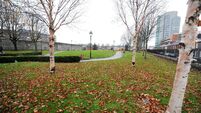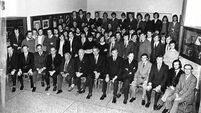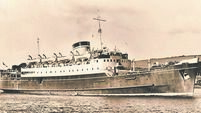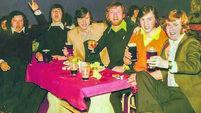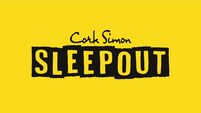Recalling the days of Orange Lodge meetings in Cork city
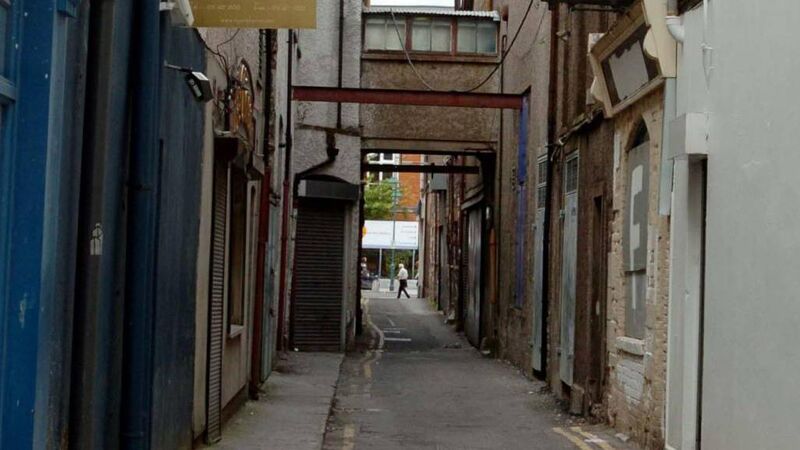
Faulkner’s Lane in Cork city, where there used to be an Orange Lodge meeting hall in the 19th century
THE picture of Joey Kerrigan leading a group of Civil Defence volunteers through Ovens Caves, which we featured in last week’s Throwback Thursday, sparked some happy memories among readers.
Aidan Vaughan wrote to tell me: “I knew your late Dad well. We were work colleagues in Sawmill Street Tech in the 1970s. Can you visualise this scene: Your Dad leading his pupils to their classroom. He has a pipe in his mouth with a chain dangling from it. There is a handwritten message on the pipe. ‘I am a chain smoker’. Ah, those were the days…”
Michael Ryan also had happy memories of schooldays at Sawmill Street.
“I had the privilege to be taught science by your father. He encapsulated everything in his teaching. A stickler he was for precision.
“I recall a time I got 98 per cent in science, he said I measured something in it 2mm short. I disputed it, but there was no giving in with him.
“A man of great ability, he won the pole vault at school sports! He enthralled us with fabulous stories, like how he bought a set of false teeth because there was two gold teeth in them. You wouldn’t know whether to believe him or not!
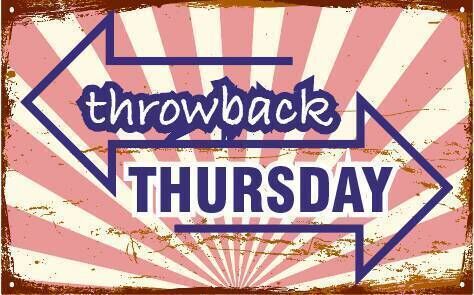
“Another story he had was a book he bought second hand that was signed by Robert Louis Stevenson.
“There were plenty of funny moments in the science classes, like the fellas who took the phosphorus out of the jar and put in their trouser pockets, where of course it went on fire!
“The young lads were a bit slow on the uptake, I’d say, they obviously weren’t tuned in to what he was saying in the class! I could talk about the classroom antics all day.”
Well, we hope you will give us more detail on the fun and games of schooldays in a future Throwback Thursday, Michael, but we can tell you right now that any story he told you was absolutely true.
He was delighted to find those gold teeth (although my mother did raise her eyebrows slightly when he brought them home and displayed them triumphantly at the dinner table).
On another occasion, he unearthed a doctor’s medical bag, complete with all the drugs, needles, etc, inside. Can you imagine such a thing being found today and the ructions it would cause?
False teeth, drugs, diamonds, a concert harp, a mandolin - he found them all down on the Coal Quay, back in the days when it was still a marvellously Dickensian Gorbals, with cave-like entrances to dark regions where terrifying ‘shawlies’ sat atop piles of second-hand clothes and rags, and you traded insults with them at your peril.
My father had that gift of getting on with everybody, though, and rummaged through the old cardboard boxes and heaps of rubbish happily whenever he could.
Now, where the Queens of the Quay once held court, there are fashionable pubs and cocktail bars, and the trendy set meet to exchange gossip. You do wonder though if late at night the echoes of the past can be heard, hoarse voices shouting from one corner to another of the vast old building, the slap of loose shoes on cobbles, the chink of coin passing from one hand to another.

A place like the Coal Quay holds on to its history, whatever modern development tries to drape over it. (And yes, I know, strictly speaking it’s Cornmarket Street, but to all of us who grew up in this wonderful city, it has always been the Coal Quay.)
Aidan Vaughan also contributed another piece of insight to the mysterious jigsaw of Cork’s old and forgotten tunnels.
“I don’t know if you already know this, but there is a tunnel stretching from the present Blair’s Hill Nursing Home across Sundays Well Road to the now vacant Sundays Well Church. It is blocked off now, of course. The building on the hill was at one time a convent.”
No, we didn’t know of that one, Aidan, and thank you for telling us. Was it the result of raising the street level, or a secret passageway for quite another purpose?
Sometimes, you can discover things by looking at the level of streets and the position of the houses. Are the properties several steps down from the thoroughfare? Are they facing in odd directions, suggesting a former laneway, now disappeared? Every clue helps to fill in the picture.
And, speaking of laneways, Patrick O’Donovan, who contributes much valuable historical information to Facebook via the Cork Historical Society’s page and also his own, Potlucks Cork Historical Page, contacted us to say he had noticed our Throwback Thursday piece last week which mentioned the Examiner office and Le Chateau’s passageway connecting it with Kealys.
“Le Chateau bought Kealys in 1973, and the USP at the time was that they now had entrances on Academy Street, Patrick Street, and Faulkners Lane,” said Patrick.
Well, as any smooth operator will tell you, never go into a place that doesn’t have at least two exits. Three is extra safe!
The reason Patrick has written was to let us know that there was a large meeting room or hall on Faulkners Lane.
“It was called The Cumberland Rooms, and was used by ‘Orange’ protestants in the 19th century,” he explained. “After some outrages and riotous assembly in the city, the Orange societies were outlawed in the mid-1840s but the hall continued in use, being taken over in the 1860s by the Oddfellows Society, a mutual assistance body much like the Masons, but without the religious mysteries elements. It still exists in America, but it slowly died out in Cork in the ’20s and ’30s as the last old timers passed away.
“I have extensively searched online Cork papers on the subject and its ‘surreptitious’ use as an Orange Lodge meeting hall is discussed as far back as the 1830s.
“The Orange Lodge system was very attractive to the British soldiers in the city then, so much so that attending lodge meetings or wearing party emblems or favours was strictly forbidden by a later order.”
Patrick, from Turner’s Cross, is a long-time fan and user of the city’s old fire maps.
“These used to be online at Cork Past and Present, but were dropped after the portal design last year. I saved them all before they left, fearing just such a future move by the library archives,and these I have also studied extensively. There appears to have been a first floor hall that they rented out to societies.”
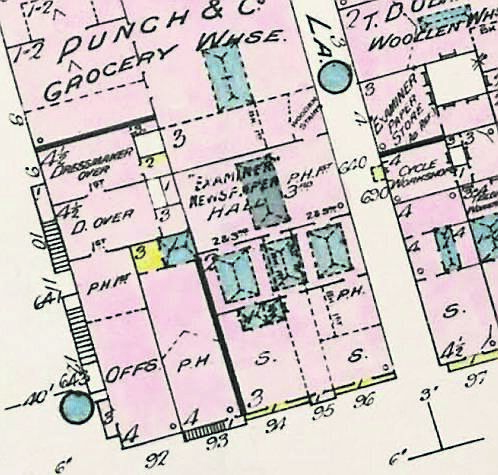
Obligingly, Patrick has sent us two of the maps in question, the first from 1897 and the last from 1961.
“My strong suspicion is that Hallorans pub was the entrance to this hall,” he said “There were two pubs on the street in the 1900s, O’Hallorans and Hoares, the later Kealys. The maps are not very forthcoming on what level the hall was on.
“If there were old architectural drawings of the Examiner office at time of construction or subsequent alteration, that would indeed be great!”
Well, aren’t you the great researcher, Patrick! That is really fascinating detail on the old lanes of our city and the uses to which they were put. More power to your elbow!
I’m going over to check those Facebook pages right now.
And speaking of tireless research, remember that marvellous old picture of an elderly lady sitting on the steps of No.8, North Mall, that we showed a few weeks ago, supplied to us by Fintan Bloss, who found it in his family album with no explanation of who she was, or why it was there, other than that the name Kate Davis was written on the back, and that it came from the Rembrandt Studio?
Well, Frank Roche saw this as a challenge and really got to work on the research, checking out the censuses, street directories, and everything else he could think of.
“I located details of the Rembrandt Studio in Guy’s Directory of 1935. The entry for 27, North Main Street reads ‘Healy Sean, confectionery’ (and) ‘Vanbrook J, photo studio’ - this was John Vanbrook of Glanmire. It’s more likely that whoever took the photo got their film developed and printed by John Vanbrook at the Rembrandt Studio. One of his ads in the 1934 Echo offers to develop a Kodak Brownie No. 2 film and provide 8 prints for one shilling - which would have been approximately the price of 2 loaves of bread at that time.
Here is Frank’s exhaustive summary of Kate (Hourihan) Davis, which reflects weeks of hunting, checking and noting.
“Catherine Hourihan was born in the village of Ballincollig in 1857, daughter of Timothy (Thade) Hourihan and Margaret Murphy who had married in 1852;. The couple had (at least) six more children. In various records, Timothy Hourihan is described as a charcoal burner or labourer so he may have worked in the Gunpowder Mills.
“In 1883, Kate married Joseph Davis, a Londoner who was an army pensioner: the couple had no children. In the census of 1901, they are living with Kate’s widowed mother who had a boarding house in Ballincollig. By 1911, her mother having died, Kate and Joseph were living at 357, Blarney Street.
“On St Patrick’s Day, 1911, Joseph Davis died so the census two weeks later shows ‘Catherine Davis, widow, 50’ living alone (she would in fact have been 53).
“At marriage, Kate is recorded as a laundress and in Census 1901 as a domestic servant. In 1911 she is described as a ‘shore woman’.
“The Cork Examiner of July23, 1937 tells us, ‘A woman named Kate Davis, 357, Blarney Street, Cork, fell on some steps at Winter’s Hill last night. She broke her ankle and having been treated at the North Infirmary, was subsequently removed to the Co. Home where she is detained. She is aged 78 years.’ Was this possibly why Kate was photographed sitting on a rug on the steps of 8, North Mall?
“It is likely that it was after her fall that she came to live at Kyle Street. In the street directories from 1930 to 1945, ‘Mrs Hourihan, clothes dealer’ is listed at 9, Kyle Street. This Mrs Hourihan, nee Hayes, was the wife of Daniel Hourihan, a son of Kate’s brother John who lived in Grattan Street - so Kate was living with her nephew and his wife in Kyle Street.
“Kate died in 1942 at the age of 85 (her death record says 67 but the Examiner’s ‘aged 78’ in 1937 was much closer to her true age). She was buried in Ovens; her brother John (died 1922) and his son Daniel (died 1943) were also buried in Ovens, but their wives, who came from North Main Street and Evergreen Street, were buried in St Joseph’s and St Finbarr’s respectively.”
Can you possibly add anything to that?
Well, perhaps two questions which are rarely asked but should be. First: why was this picture taken? And second: why was it kept so carefully in the Bloss family album? It would be good to know, wouldn’t it?
Let us know your thoughts and memories. Email jokerrigan1@gmail.com or leave a comment on our Facebook page: https://www.facebook.com/echolivecork.
